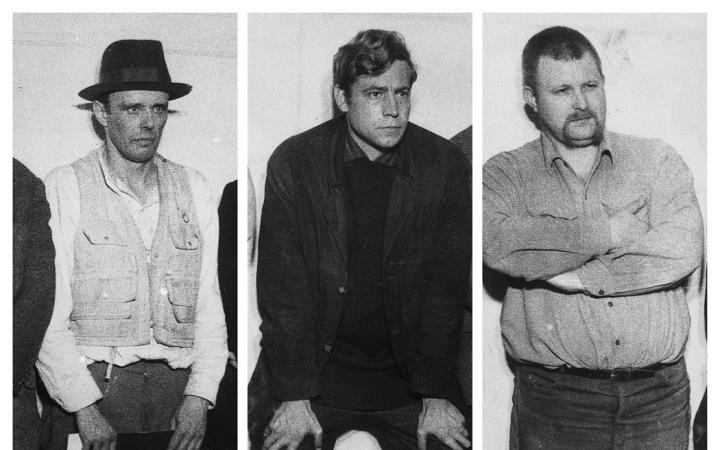Beuys Brock Vostell – An Introduction to the Exhibition

In the first half of the twentieth century the European avant-garde abandoned the classic mission of art; namely, the representation of reality. Whereas after Kazimir Malevich this resulted in abstraction, in the self-expression of the means of representation, with Marcel Duchamp we see the self-expression of objects; namely, the substitution of representation with reality. The neo-avant-gardes of the second half of the century not only elaborated these tendencies and radicalized them, they transformed art by means of the massive impact of the media photography, film, video, and the computer, as well as the action. Poetic, pictorial, or sculptural actions – whether by the artist or the public – replaced aesthetic objects and dissolved the borderlines between time-based and spatially based art, as well as the separation of art and life. Several artists in Germany, such as Wolf Vostell, Bazon Brock, and Joseph Beuys (listed in chronological order of appearance), became aware of these new tendencies very early on, in the 1950s, and began implementing them in artistic practices.
Until now, art history has focused on the singularity of the oeuvres of these three artists, divorced from their respective national and international contexts. This has resulted in important aspects and achievements of all three artists being neglected and, moreover, this lack of contextual assessment has led to their significance being overlooked for the further development of modernity. To remedy this situation in some measure the actions, demonstrations, and performances of these three key German artists of the post-war era are now to be presented together in a major exhibition entitled Beuys Brock Vostell at the ZKM | Museum of Contemporary Art. What speaks in favor of bringing the three approaches to art together is not only their programmatic congruities, but also the fact – often overlooked – that the three artists were friends and used to appear together at important festivals and exhibitions during the 1960s. The »Festival der Neuen Kunst am 20. Juli 1964«, the live ZDF broadcast for the series »Die Drehscheibe« (1964), and the so-called »24 Stunden Happening« at the Galerie Parnass in Wuppertal (1965) are just a few of the occasions attended by all three artists. Each in his own way, Beuys, Brock, and Vostell learned from the war experience, the Holocaust, and totalitarian systems: the first lesson was the conviction that teaching itself should be defined in a new way. They invented teaching as performance art, the essence of which pivoted on imparting knowledge and facilitating insights, acting and agitating, the polemic (Brock), the educational (Beuys), the propagandistic (Vostell), and discussion and demonstration. The European traditions they drew on included Enlightenment, Protestantism, idealist philosophy, and Romanticism.
“The Ego is […] both the acting and product of the act; the active and the result of the activity; deed and act is one; and hence the I am is expressive of a deed-act […].“
In 1794/1795 Johann Gottlieb Fichte began his »Grundlage der gesammten Wissenschaftslehre« [Foundations of the Science of Knowledge] by defining the Ego, or what he calls the Ego: “The Ego is […] both the acting and product of the act; the active and the result of the activity; deed and act is one; and hence the I am is expressive of a deed-act […].“[1] The intention of interlinking art and life is an echo of Romanticism. The programmatic battle cry of Fluxus, Happening, and Action Art – above all Wolf Vostell’s motto “Art is life – life is art“(1961) – goes back to the writer Ludwig Tieck and his »Phantasien über die Kunst für Freunde der Kunst« [Fantasies on Art for Friends of Art] (1799): “Let us transform our lives into works of art.“[2] Thus, one of their goals was to reform or revolutionize life, to democratize and civilize society. The radical emancipation of the individual was to be achieved by transforming consciousness and this would be set in train by artistic actions, paintings, and speeches. Joseph Beuys, Bazon Brock, and Wolf Vostell presented foundational positions of performativity and thus they expanded the definition of an artwork. Literature turned into action literature and participatory multimedia theater (Brock); painting and collage transformed into action painting and Dé-coll/age on the street and, ultimately, into happenings that included the audience (Vostell); and sculpture turned into “social sculpture“, action music, and demonstrations (Beuys) – all with a focus on interaction and audience participation, the transmission of knowledge and teaching as art. Sketches, drawings, and texts, the tools of action, artifactual objects and reconstructions as well as photographs, and films – discovered or rediscovered in the course of years of research and seldom or never exhibited before – together form a script with which actions become rememberable, readable, and visual. The exhibition does not show the complete works of Beuys, Brock, and Vostell, but the individual as well as the collective periods of developing the new art as a form of action. To facilitate better understanding the initial conditions, the early drawings, poems, paintings, and sculptures, as well as the later objects, installations, and environments are presented that resulted from the actions. A sourcebook accompanying the exhibition will be available containing documents, letters, photographs, filmstills, newspaper articles, and other material on the individual and particularly the joint actions of Joseph Beuys, Bazon Brock, and Wolf Vostell in the period 1958 to 1977. A team of scholars has produced a carefully researched timeline which provides a comprehensive index of all collaborations of Beuys, Brock, and Vostell.
1 Johann Gottlieb Fichte, »The Science of Knowledge«, translated from the German by A. E. Kroeger, Trübner & Co, Ludgate Hill, London, 1889, p. 68f.
2 Ludwig Tieck and Wilhelm Heinrich Wackenroder, »Phantasien über die Kunst, für Freunde der Kunst« [Fantasies on Art for Friends of Art], Ludwig Tieck (ed.), Friedrich Perthes, Hamburg, 1799, p. 130,